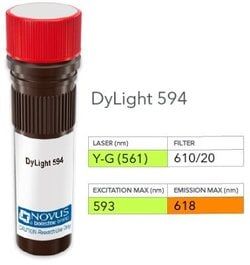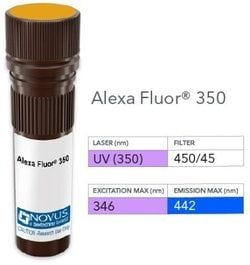Cytochrome c Antibody (7H8.2C12 + CYCS/1010), DyLight 350, Novus Biologicals™
Manufacturer: Novus Biologicals
Select a Size
| Pack Size | SKU | Availability | Price |
|---|---|---|---|
| Each of 1 | NB007166-Each-of-1 | In Stock | ₹ 57,494.00 |
NB007166 - Each of 1
In Stock
Quantity
1
Base Price: ₹ 57,494.00
GST (18%): ₹ 10,348.92
Total Price: ₹ 67,842.92
Antigen
Cytochrome c
Classification
Monoclonal
Conjugate
DyLight 350
Formulation
50mM Sodium Borate with 0.05% Sodium Azide
Gene Symbols
CYCS
Immunogen
Synthetic peptides corresponding to amino acid 1-80, 81-104 and 66-104 of pigeon cytochrome c (7H8.2C12); Recombinant full-length human CYCS protein (CYCS/1010) (Uniprot: P99999)
Quantity
0.1 mL
Research Discipline
Apoptosis, Cellular Markers, Cholesterol Metabolism, Core ESC Like Genes, Lipid and Metabolism, Mitochondrial Markers, Stem Cell Markers
Test Specificity
Cytochrome C is a well-characterized mobile electron transport protein that is essential to energy conversion in all aerobic organisms. In mammalian cells, this highly conserved protein is normally localized to the mitochondrial inter-membrane space. More recent studies have identified cytosolic cytochrome c as a factor necessary for activation of apoptosis. During apoptosis, cytochrome c is trans-located from the mitochondrial membrane to the cytosol, where it is required for activation of caspase-3 (CPP32). Overexpression of Bcl-2 has been shown to prevent the translocation of cytochrome c, thereby blocking the apoptotic process. Overexpression of Bax has been shown to induce the release of cytochrome c and to induce cell death. The release of cytochrome c from the mitochondria is thought to trigger an apoptotic cascade, whereby Apaf-1 binds to Apaf-3 (caspase-9) in a cytochrome c-dependent manner, leading to caspase-9 cleavage of caspase-3. This monoclonal antibody recognizes total
Content And Storage
Store at 4°C in the dark.
Applications
Western Blot, Flow Cytometry, Immunohistochemistry, Immunohistochemistry (Paraffin), Immunofluorescence
Clone
7H8.2C12 + CYCS/1010
Dilution
Western Blot, Flow Cytometry, Immunohistochemistry, Immunohistochemistry-Paraffin, Immunofluorescence
Gene Alias
CYCHCS, cytochrome c, cytochrome c, somatic, THC4
Host Species
Mouse
Purification Method
Protein A or G purified
Regulatory Status
RUO
Primary or Secondary
Primary
Target Species
Human, Rat
Isotype
IgG2b κ
Related Products
Description
- Cytochrome c Monoclonal specifically detects Cytochrome c in Human, Rat samples
- It is validated for Western Blot, Flow Cytometry, Immunohistochemistry, Immunohistochemistry-Paraffin.


